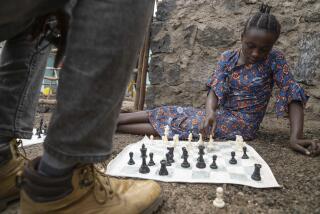Chess Whiz Ponders His Next Move
After Adam Lief, a Los Alamitos High School senior, won his national title this summer, he contacted several universities to check on the availability of scholarships.
Despite his accomplishments, he was turned down.
“They don’t give out chess scholarships,” he said, “but it will help me get in. They’re looking for people a little bit different, and,” he grinned, “I’m fairly decent at chess.”
After learning chess moves at 4 1/2 but starting to bear down only about four years ago, Adam, who is 16, is becoming known in the chess world.
“He’s one of our most promising junior players,” said Randall Hough, technical director of the United States Chess Federation. “He hasn’t had any real international experience yet, but with these accomplishments at this stage, it’s quite possible he has a bright international future ahead of him.”
Adam won the U.S. Junior Open Tournament last July in Berkeley, winning all his games, including a crucial one against 19-year-old Dennis Monokroussos of Las Vegas. Adam had been the top seed, and Monokroussos, the second seed, was expected to be his toughest competition.
The victory was, in Hough’s words, Adam’s “big splash.”
In August, Adam played in two tournaments simultaneously--the U.S. Open Championship, which includes all ages, and the Tournament of State High School Champions--both held in Hollywood, Fla.
“He did very well, considering the level of his opponents,” Hough said. “He played at least a couple of grandmasters.”
Adam tied with one other player for the U.S. Open’s under-18 prize and tied for third in the high school tournament.
Points gathered from the summer’s tournaments leave him only nine points shy of the 2,400 needed to qualify as a senior master, the highest ranking awarded by the U.S. Chess Federation. (Grandmaster and international grandmaster rankings are earned in international play.)
Among players 17 and younger, there are only three players in the country who rank higher than Adam, Hough said.
Could Be ‘the Best’
For Adam, whose room in his Rossmoor home is dominated by a large bookcase holding chess manuals, chess notes, chess score sheets and post cards for his several chess-by-mail games, chess holds the allure of a potential way of life.
“It’s not just a game,” he said. “It’s a sport, a science, an art. People marvel at how you can pursue it for money. But if you’re the best, you can make a lot of money.”
Adam said he has not decided whether to pursue chess that far--”I will probably make that decision in college”--but he said he believes that with enough work he could become “the best.”
“I have that option of turning professional,” he said. “It’s not really the money right now. It’s the desire to be the best in the world.”
It was hard to start from scratch and become a highly ranked chess player, he said. His mother, Judy Lief, taught him the moves, and his father, Jack Lief, a marketing executive, taught him elementary strategy. Since then, he has been taking lessons.
“But I think it’s going to be harder getting from this point to my goal, which is world champion,” he said.
Adam has mapped out how he might do it. He will continue competing in tournaments, “in international tournaments--that’s really the key. The international rating system is much more demanding.”
Because Adam won the national junior open championship, he automatically receives a place in the by-invitation-only national tournament for juniors next summer. Winning there would provide money for expenses and open other doors.
Major in Mathematics
College will fall in there somewhere--hopefully at Yale, Harvard, Stanford or UC Berkeley, the universities where he plans to apply. He expects to major in mathematics and at the same time calculate whether he should turn chess professional.
“It’s hard to predict how good he will be,” Hough said. “It’s harder to predict than in athletics. It’s the frame of mind. Frequently kids get tired of chess. Players have to study; it’s just like homework.”
Adam realizes that, too.
If he is to be world champion, it would be, “let’s say, 1991,” he said. “That’s just a guess, but about every two years they have a new champion, so it’s possible.
“Either that or I’ll drop out.”
Play-by-Play
White Black White Black Monok’sos Lief Monok’sos Lief 1 P-K4 P-QB3 18 Q-N5 N-B4 2 P-Q4 P-KN3 19 BxRch KxB 3 N-QB3 B-N2 20 BxB KxB 4 N-B3 P-Q3 21 Q-K3 N-K3 5 P-KR3 N-Q2 22 N-K2 B-R3 6 B-K2 P-K4 23 KR-K1 P-B4 7 O-O KN-B3 24 P-QB3 PxRP 8 B-K3 O-O 25 PxP B-B5 9 PxP PxP 26 R-N1 R-QN1 10 Q-Q2 Q-B2 27 P-B3 P-R5 11 QR-Q1 R-K1 28 P-N3 R-N6 12 B-QB4 P-QN4 29 Q-B1 Q-N2 13 B-N3 P-QR4 30 K-B2 Q-N4 14 N-N5 R-B1 31 RxR PxR 15 P-QR3 P-R3 32 Q-N2 BxN 16 NxBP RxN 33 RxB P-B5 17 BxP P-N5 Resigns
More to Read
Go beyond the scoreboard
Get the latest on L.A.'s teams in the daily Sports Report newsletter.
You may occasionally receive promotional content from the Los Angeles Times.










